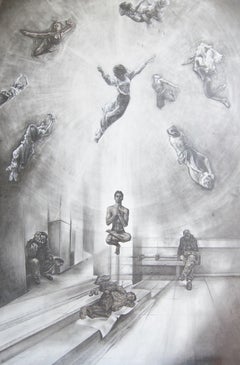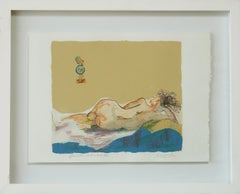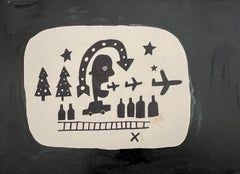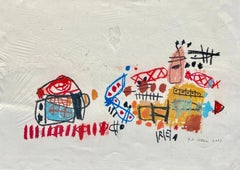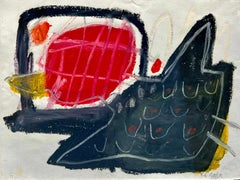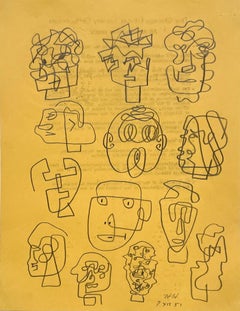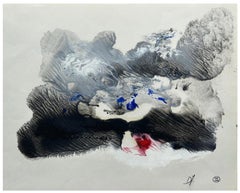Trimper Gallery Abstract Drawings and Watercolors
to
3
12
1
1
Overall Width
to
Overall Height
to
17
12
2
2
13
4
15
11
11
2
2
2
1
17
Kyle Andrew Szpyrka - Lotus, Drawing 2015
By Kyle Andrew Szpyrka
Located in Greenwich, CT
Sutra, a Sanskrit word meaning “thread”, is a word or small group of words that summarize an entire complex web of ideas, truths, wisdoms, or teachings all woven together into a sing...
Category
2010s Surrealist Figurative Drawings and Watercolors
Materials
Paper, Pencil, Graphite
Kyle Andrew Szpyrka - Learning to Fly, Drawing 2015
By Kyle Andrew Szpyrka
Located in Greenwich, CT
Sutra, a Sanskrit word meaning “thread”, is a word or small group of words that summarize an entire complex web of ideas, truths, wisdoms, or teachings all woven together into a sing...
Category
21st Century and Contemporary Surrealist Figurative Drawings and Waterco...
Materials
Paper, Foam Board, Pencil, Graphite
Cecilia Arrospide - DESCANSANDO II, Drawing 2019
By Cecilia Arrospide
Located in Greenwich, CT
Engraving Intervened
My work is mainly abstract, I would say abstract expressionism. I love painting with oils, they give me many possibilities I do no find in other media. When w...
Category
2010s Conceptual Figurative Drawings and Watercolors
Materials
Paper, Engraving
Ryan Cronin - Happy Holidaze, Drawing 2000
Located in Greenwich, CT
Happy Holidaze
Ryan Cronin
Sharpie on Paper
30" x 22.5"
When people look at his work Cronin wants them to feel an immediate impact, even if they’re not sure what hit them. The raw, ...
Category
2010s Abstract Mixed Media
Materials
Paper, Oil Pastel
Ryan Cronin - R/E/A, Drawing 2003
Located in Greenwich, CT
R/E/A
Ryan Cronin
Oil-Based Pastel on Paper (ND)
30" x 22.5"
When people look at his work Cronin wants them to feel an immediate impact, even if they’re not sure what hit them. The ...
Category
2010s Abstract Mixed Media
Materials
Paper, Oil Pastel
Ryan Cronin - Duck, Drawing 1999
Located in Greenwich, CT
Duck
Ryan Cronin
Oil Stick on Paper (ND)
30" x 22.5"
When people look at his work Cronin wants them to feel an immediate impact, even if they’re not sure what hit them. The raw, alm...
Category
2010s Abstract Mixed Media
Materials
Paper, Oil
Ryan Cronin - X Marks the Spot, Drawing 2002
Located in Greenwich, CT
X Marks the Spot
Ryan Cronin
Oil-Based Pastel on Paper
30" x 22.5"
When people look at his work Cronin wants them to feel an immediate impact, even if they’re not sure what hit them...
Category
2010s Abstract Mixed Media
Materials
Paper, Oil Pastel
Ryan Cronin - Heads and Tails, Drawing 2009
Located in Greenwich, CT
Heads and Tails
Ryan Cronin
Oil Pastels on Paper
30" x 22.5"
When people look at his work Cronin wants them to feel an immediate impact, even if they’re not sure what hit them. The ...
Category
2010s Abstract Mixed Media
Materials
Paper, Oil Pastel
Ryan Cronin - Chicken Wing, Drawing 2009
Located in Greenwich, CT
Chicken Wing
Ryan Cronin
Oil Pastels on Paper
30" x 22.5"
When people look at his work Cronin wants them to feel an immediate impact, even if they’re not sure what hit them. The raw...
Category
2010s Abstract Mixed Media
Materials
Paper, Oil Pastel
Ryan Cronin - Chainsaw, Drawing 2002
Located in Greenwich, CT
Chainsaw
Ryan Cronin
Oil Pastels on Paper
30" x 22.5"
When people look at his work Cronin wants them to feel an immediate impact, even if they’re not sure what hit them. The raw, al...
Category
2010s Abstract Mixed Media
Materials
Paper, Oil Pastel
Ryan Cronin - Mt Moped, Drawing 2002
Located in Greenwich, CT
Mt Moped
Ryan Cronin
Oil Pastels on Paper
30" x 22.5"
When people look at his work Cronin wants them to feel an immediate impact, even if they’re not sure what hit them. The raw, al...
Category
2010s Abstract Mixed Media
Materials
Paper, Oil Pastel
Ryan Cronin - Untitled III, Drawing 2009
Located in Greenwich, CT
Untitled III
Ryan Cronin
Oil Pastels on Paper
30" x 22.5"
When people look at his work Cronin wants them to feel an immediate impact, even if they’re not sure what hit them. The raw...
Category
2010s Abstract Mixed Media
Materials
Paper, Oil Pastel
Ryan Cronin - Untitled II, Drawing 2006
Located in Greenwich, CT
Untitled II
Ryan Cronin
Oil Pastels on Paper
30" x 22.5"
When people look at his work Cronin wants them to feel an immediate impact, even if they’re not sure what hit them. The raw,...
Category
2010s Abstract Mixed Media
Materials
Paper, Oil Pastel
Ryan Cronin - Untitled '25, Drawing 2025
Located in Greenwich, CT
Low Tide
Ryan Cronin
Oil Pastels on Paper
30" x 22.5"
When people look at his work Cronin wants them to feel an immediate impact, even if they’re not sure what hit them. The raw, al...
Category
2010s Abstract Mixed Media
Materials
Paper, Oil Pastel
Ryan Cronin - Low Tide, Drawing 2006
Located in Greenwich, CT
Low Tide
Ryan Cronin
Oil Pastels on Paper
30" x 22.5"
When people look at his work Cronin wants them to feel an immediate impact, even if they’re not sure what hit them. The raw, al...
Category
2010s Abstract Mixed Media
Materials
Paper, Oil Pastel
Nicolas V. Sanchez - Mariana Mirage, Drawing 2022
Located in Greenwich, CT
charcoal on paper
Nicolas V. Sanchez received his BFA from Kendall College of Art and Design in Grand Rapids, MI and his MFA from the New York Academy of Art. While at the Academy, ...
Category
2010s Contemporary Abstract Drawings and Watercolors
Materials
Canvas, Charcoal
Price Upon Request
Nicolas V. Sanchez - Mariana Mirage, Drawing 2022
Located in Greenwich, CT
charcoal on paper
Nicolas V. Sanchez received his BFA from Kendall College of Art and Design in Grand Rapids, MI and his MFA from the New York Academy of Art. While at the Academy, ...
Category
2010s Contemporary Abstract Drawings and Watercolors
Materials
Canvas, Charcoal
Price Upon Request
Related Items
A Whimsical 1950s Mid-Century Modern Abstract Portrait Study, Composite Drawings
By Harold Haydon
Located in Chicago, IL
A Whimsical 1950s Mid-Century Modern Abstract Portrait Study (Composite Drawings) by Noted Chicago Artist, Harold Haydon (Am. 1909-1994). A humorous and visually striking sheet of a...
Category
Mid-20th Century American Modern Figurative Drawings and Watercolors
Materials
Paper, Graphite
$135
H 15 in W 12 in D 0.13 in
Abstract composition
By Dora Maar
Located in PARIS, FR
Dora Maar
Abstract composition
Oil on paper
21 x 29.5 cm (31,2 x 39,3 cm with frame)
Signed lower right
Stamp of the sale of his estate (1998) lower right
Category
20th Century Abstract Abstract Drawings and Watercolors
Materials
Paper, Oil
'Mid-century Abstract', NYMoMA, Paris, XXXII Venice Biennale, MALI, Lima, Peru
By Emilio Rodríguez Larraín
Located in Santa Cruz, CA
'Midcentury Biomorphic Abstract', NYMoMA, Paris, XXXII Venice Biennale, MALI, Lima, Peru
Signed, lower right, 'E.R. Larrain' for Emilio Rodríguez Larraín (Peruvian, 1928-2015), and inscribed 'Roma, Nov 1963, Enero 1964'. (Rome, Nov 1963-January 1964). Verso titled, "L'Homme C'est Sujet à Errer" (Man Tends to Wander), and bearing the artist's self-portrait in india ink and wash.
Exhibited: XXXII Venice Biennale, 1964. (original exhibition label verso)
Previously with Staempfli Galleries, New York. This painting is registered in the Archives of American Art as 'Staempfli Gallery, inventory #775'.
A monumental and historically distinguished work by this groundbreaking Peruvian Modernist who drew inspiration from Peruvian indigenous and pre-colonial culture. The paintings of Emilio Rodríguez Larraín are held in the permanent collections of museums worldwide including the Musée de la Ville de Paris, Peru's Museo de Arte de Lima and the Museum of Modern Art in New York. This painting was selected by the Peruvian Government for exhibition at the XXXII Venice Biennale in 1964 and is the largest single recorded work by the artist.
Emilio Rodríguez Larraín received his Bachelors of Architecture in 1949 from Peru's Universidad Nacional de Ingeniería and held his first solo exhibition in Lima after visiting Europe in 1950. In 1951, he returned to Europe in the company of the artists Alfredo Ruiz Rosas and Joaquín Roca Rey...
Category
1960s Abstract Abstract Drawings and Watercolors
Materials
Fiberboard, Laid Paper, Oil
$38,500
H 67 in W 91 in D 2.75 in
"Colorful Geometric Abstraction, " Simon Samsonian, Armenian Artist
Located in New York, NY
Simon Samsonian (1912 - 2003)
Colorful Geometric Abstraction, 1981
Oil on paper
16 x 22 inches
Signed and dated lower right
Provenance:
Estate of the artist
This survivor of the Armenian genocide wound up in a Cairo orphanage in 1927. He rose to fame as one of Egypt’s great modernists, but after moving to Long Island late in life he withdrew into anonymity. Now his compelling story is being told. Art historians are finally beginning to realize that the power of abstraction in its early years was a zeitgeist not limited to the major European centers of the avant-garde — Paris, Munich, and Moscow — but one that quickly rippled to major cities throughout the world. Within a few decades that original shock of a new vision had inspired thousands of artists from different cultures — particularly those the Middle East — whose translations were not slavish imitations of works by seminal figures like Picasso, Braque, Malevich, and Kandinsky but creative variants colored by their respective cultures.
This essay focuses on an extraordinary Armenian artist, his harrowing survival of the genocide, his rise to fame in Cairo, and his creation of a unique style of abstraction. Art historians have typically formed a chorus that teaches the history of abstraction like this: Just before and during the World War I era, several avant-garde artists emerged to create shockingly different new forms by which artists could express themselves. In Paris, Picasso and Braque broke out with cubism, quickly followed by Mondrian. In Moscow, Malevich created Suprematism, the ultimate hard-edge geometric abstraction. And in Munich, Kandinsky emerged as the father of Abstract Expressionism. Within these few short years a zeitgeist was sensed throughout the art world. American pioneers, too — particularly Stanton Macdonald-Wright and Morgan Russell — felt this explosive freedom of expression. When Europe was recovering after World War I it became clear that Paris would retain its title as capitol of the art world, lasting through the Roaring Twenties and even through the Great Depression. But the end of World War II changed everything. A parallel war had been won by a group of irascible young Abstract Expressionists in New York — led by Pollock, Rothko, DeKooning, and Kline. No sooner had Paris been liberated from the Germans than Picasso, Matisse, Breton, and Duchamp surrendered to the Americans. From that point on New York would be the epicenter of the art world.
But a lens that focuses myopically on the war between the avant-garde of Paris and New York misses the wider narrative of multiple aesthetic modernities that developed in the several decades following World War I. For Armenian artists the matter is even more complex owing to the genocide of 1915 where more than 1.5 million people — seventy-five percent of Armenians in the Ottoman Empire — were massacred. Those not shot on the spot were sent on death marches through the Mesopotamian desert without food or water. Frequently, the marchers were stripped and forced to walk naked under the scorching sun until they dropped dead.
As a child Samsonian witnessed the murder of his parents and most of the members of his family. Soon thereafter, his older sister, Anahid, quickly shepherded him into a line of children being rescued by Greek nuns. But they became separated and he lost her, too. He was sent to a Greek orphanage in Smyrna (now Izmir), on Turkey’s west coast. Because he only knew his first name, the orphanage gave him a last name based on the place where they found him — Samsun — a major port on Turkey’s north coast on the Black Sea. His birth date was unknown, too. According to Samsonian’s vague recollections he assumed he was about three or four years old at the onset of the genocide, which would place his birth year in 1911 or 1912. In 1922, when Samsonian was about 10, the Turks ended their war with the Greeks by putting Smyrna to the torch in what has been called the “Catastrophe of Smyrna.” Once again, the child was on the run, escaping the fire and slaughter. He found temporary refuge in Constantinople, but within a year that major port would fall to the Turks, too, and become renamed as Istanbul. This time, Samsonian was whisked away to an orphanage in Greece founded by the American charity, Near East Relief — which is credited with saving so many Armenian orphans that the American historian Howard M. Sachar said it “quite literally kept an entire nation alive.
Any understanding of Samsonian’s approach to modernism requires careful consideration of the impact of his early years because his art is inseparable from the anguish he experienced. In 1927, when he was a teenager, he was transferred to Cairo, Egypt, then a cosmopolitan city hosting a sizable portion of the Armenian diaspora. There he lived with thirty-two other children on the top floor of the Kalousdian Armenian School. Upon graduating in 1932 he won a scholarship to attend the Leonardo da Vinci Art Institute — an Italian art school in Cairo — where he won first prize in final examinations among one hundred students. He found work with an Armenian lithographic printer and he returned to the Kalousdian Armenian School to teach drawing. In 1939 he married one of his students, Lucy Guendimian.
The Cairo in which Samsonian matured as an artist was home to many prominent art collectors after World War I. In this receptive environment Samsonian exhibited widely and won many awards. Beginning in 1937 and for the next thirty years he exhibited annually at the prestigious Le Salon du Caire hosted by the Société les Amis de l’Art (founded in 1921). After World War II he hit his stride as a modernist in Cairo, counting among his peers other artists of the Armenian diaspora such as Onnig Avedissian, Achod Zorian, Gregoire Meguerdichian, Hagop Hagopian...
Category
1980s Abstract Geometric Abstract Drawings and Watercolors
Materials
Paper, Oil
Abstract Expressionist Rue de Paris Oil on paper - Transfer Monotype
Located in Soquel, CA
Abstract Expressionist Rue de Paris
Original transfer Monotype painting by California artist Heather Speck (American 20th C) abstract scene using oil and...
Category
1990s Abstract Expressionist Abstract Drawings and Watercolors
Materials
Paper, Oil, Monotype
$700 Sale Price
20% Off
H 11.25 in W 15 in D 0.07 in
Infanta XLVIII (Abstract Figurative Graphite Drawing in Antique Pewter Frame)
By David Dew Bruner
Located in Hudson, NY
Abstract graphite drawing on paper in vintage pewter frame
5.75 x 4.5 inches
This abstract figurative graphite drawing on paper was inspired by academic...
Category
2010s Abstract Abstract Drawings and Watercolors
Materials
Paper, Graphite
$350
H 5.75 in W 4.5 in D 1 in
Field Study #749
By Terrell James
Located in Houston, TX
Terrell James
Field Study #749, 2020
Oil on vellum
20 x 16 in (50.8 x 40.6 cm)
Category
21st Century and Contemporary Abstract Abstract Drawings and Watercolors
Materials
Oil, Vellum
1960s American Pop Art hyperrealist drawing Lucky Strike
Located in Norwich, GB
A striking pop art drawing, dating from the 1960s, featuring lettering and a packet of Lucky Strike cigarettes. Pop art as art movement emerged in the 1950s and flourished in the 196...
Category
1960s Pop Art Figurative Drawings and Watercolors
Materials
Graphite
Mid Century Abstract Expressionist Charcoal Drawing
By John Haley
Located in Soquel, CA
Wonderful abstract expressionist drawing in shades and tones of grays and black by John Haley (American, 1905-1991), c.1956-7. Signed lower left corner. Presented in 3" mat. Condition: Very good: some edge wear consistent with age. Image size: 25"H x 19"W.
A feature of the artwork of John Charles...
Category
1950s Abstract Expressionist Abstract Drawings and Watercolors
Materials
Charcoal, Graphite, Paper
$1,254 Sale Price
49% Off
H 31 in W 25 in D 0.01 in
Infanta IV: Figurative Cubist Abstract Graphite Drawing with Antique Frame
By David Dew Bruner
Located in Hudson, NY
Figurative abstract cubist style drawing inspired by the Infanta Margarita in an antique gold frame
“Infanta IV” by Hudson Valley artist, David Dew Bruner, made in 2015
23 x 18 inch...
Category
2010s Abstract Abstract Drawings and Watercolors
Materials
Paper, Graphite
$1,800
H 24.5 in W 19.25 in D 1 in
Plate Six from Novecento (Mixed media lithograph with chalk pastel), Signed/N
By Nam June Paik
Located in New York, NY
Nam June Paik
Untitled, Plate Six from Novecento, 1992
Mixed Media: Color offset lithograph with unique chalk pastel drawing
13 3/10 × 18 inches
Hand signed, Edition 104/130
Pencil numbered 104/130, hand signed in pastel chalk on the front
Edizioni Carte Segrete, Rome, Italy
Excellent condition; held in matting which can be easily removed
The matting measures 18" x 21"
This was part of a series of works produced for the Nam June Paik retrospective at the Palazzo delle Esposizioni, Rome, 1992, Nam June Paik: Arti Elletroniche.
This is one of the editions which bears unique hand coloring with pastel chalk.
A comparable work sold at auction in 2015 for US $12,583. (see details below):
Nam June Paik
Title Novecento
Description Nam June PAI K
Novecento 1930-1940, 1992 Pastel sur offset en couleurs, épreuve signée et numérotée 104/130 Edizioni Carte Segrete, Rome 23,5 x 39,5 cm EH Oeuvre réalisée a l'occasion de la rétrospective Paik au Palazzo delle Esposizioni, Rome, 1992, Nam June Paik: Arti Elletroniche, cinema e Media Verso il XXI Secolo
Medium pastel
Year of Work 1992
Size Height 9.3 in.; Width 15.6 in. / Height 23.5 cm.; Width 39.5 cm.
Misc. Signed
Sale of Millon & Associés: Monday, June 22, 2015 [Lot 00090]
Design
Sold For 11,057 EUR Hammer
(12,583 USD)
Nam June Paik Biography
Nam June Paik was born in 1932 in Seoul. He received a BA in aesthetics from the University of Tokyo in 1956 where he also studied music and art history. After graduating, he studied for a year with composer Thrasybulus Georgiades Georgiades at the University of Munich and for two years with composer Woflgang Fortner at the International Music College in Freiburg. He attended the International Summer Courses for New Music in Darmstadt in 1957, when he met Karlheinz Stockhausen, and in 1958, when he met John Cage. Cage, and through him Marcel Duchamp, had a significant influence on Paik as he became a major force in the avant-garde through performances. In Hommage à John Cage (1959), Paik employed audiotape and performance to attack traditional musical instrumentation and compositional practices, splicing together piano playing, screaming, bits of classical music, and sound effects. Realizing that taped sound was not enough, he decided to move into performance, first by introducing performative actions into his audio works. In 1961 Paik performed Simple, Zen for Head and Étude Platonique No. 3, in which he became a volatile figure, thrashing about in unexpected patterns and sudden movements to his signature soundtracks. In 1962 Paik participated in the Fluxus International Festival of the New Music in Weisbaden. Paik's first exhibition, entitled Exposition of Music - Electronic Television, in 1963 at Galerie Parnass at Wuppertal, launched his transition from composer and performance artist to the inventor of a new art form: an engagement with the material site of television as an instrument. In the exhibition, thirteen televisions lay on their backs and sides with their reception altered; for example, Zen for TV (1963) reduced the television picture to a horizontal line and Kuba TV (1963) shrank and expanded the image on the television set according to the changing volume.
In 1964 Paik traveled to the US. He quickly settled in New York and became a leading innovator among an emerging generation of artists seeking new modes of artistic expression and distribution. That same year, Paik collaborated with Shuya Abe to create Robot K-456 (1964), a remote controlled robot that played audiotaped speeches by John F. Kennedy and defecated beans in Paik's Robot Opera (1964). In the interactive work Magnet TV (1965), Paik invited viewers to modify the television's output into swerving abstract lines through the movement of a magnet over the TV. In 1967 Paik and frequent collaborator Charlotte Moorman were arrested when Moorman performed Paik's Opera Sextronique (1967), a striptease as she played the cello at the Filmmakers' Cinematheque in New York. Paik's TV Bra for Living Sculpture (1969), which Moorman wore in performances, featured two television tubes...
Category
1990s Abstract Mixed Media
Materials
Chalk, Offset, Oil Pastel, Mixed Media, Graphite, Lithograph
Contemporary Pastel Drawing on Paper - From the Series "Visual Diaries"
Located in Vilnius, Vilniaus apskr.
The series of works "Visual Diaries" represents drawings on paper, featuring expressive abstractions or figurations created daily by the artist. Each work’s title includes the creati...
Category
2010s Contemporary Figurative Drawings and Watercolors
Materials
Pastel, Paper
$900
H 29.14 in W 21.65 in D 0.4 in

